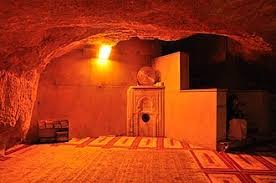Deep in the arid landscapes of Yemen’s Shabwa Governorate lies a geological and historical enigma—the Bir Ali Crater, often called the Well of Souls. This volcanic pit, shrouded in myth and ancient lore, has captivated explorers, historians, and spiritual seekers for centuries. Unlike typical tourist destinations, the Bir Ali Crater remains an off-the-beaten-path wonder, holding secrets that few outside the region know.
A Volcanic Wonder in the Desert
The Bir Ali Crater is a striking natural formation, a deep, circular depression carved by volcanic activity millennia ago. Its steep, rocky walls descend into darkness, creating an almost otherworldly appearance. The crater’s depth and isolation give it an eerie stillness, amplifying its mystical reputation. Unlike other volcanic sites, Bir Ali is not just a geological curiosity—it is a place where history, spirituality, and nature intertwine.
The Legend of the Well of Souls
Local folklore speaks of the crater as the Well of Souls, a gateway to the underworld or a resting place for lost spirits. Some believe that the crater was once used for ancient rituals, where offerings were made to appease deities or communicate with the dead. One lesser-known tale tells of a 19th-century traveler who claimed to hear whispers rising from the depths at night—voices of those who had perished in the desert. Whether myth or reality, these stories have cemented the crater’s reputation as a place of supernatural significance.
Historical Significance and Ancient Trade Routes
Long before it became known as the Well of Souls, Bir Ali was a crucial landmark for traders and travelers. Located near the ancient port of Qana, it served as a waypoint for incense caravans traveling from southern Arabia to the Mediterranean. The crater’s fresh water sources made it a vital oasis in an otherwise harsh environment. Some historians suggest that the crater may have been a sacred site for the ancient Hadhramaut and Himyarite civilizations, though much of its early history remains undocumented.
Geological Marvels and Unique Features
From a scientific perspective, the Bir Ali Crater is a fascinating study in volcanic geology. Unlike typical lava-filled craters, this one is dry, with steep basalt walls that reveal layers of ancient eruptions. Geologists believe it was formed by a phreatomagmatic explosion—a violent interaction between magma and groundwater. The crater’s microclimate supports unique plant species, some of which are found nowhere else in the region. Its sheer depth creates a temperature inversion, making it noticeably cooler at the bottom—a rare phenomenon in Yemen’s scorching deserts.

Explorers and Forgotten Expeditions
Few Western explorers have documented Bir Ali, adding to its mystique. In the early 20th century, British adventurer Freya Stark referenced the crater in her travels, describing it as “a pit of shadows where the desert breathes.” Later, in the 1970s, a Soviet geological team reportedly conducted secret surveys, searching for rare minerals. Rumors persist that they found something unusual—perhaps ancient artifacts or even hidden tunnels—but no official records were ever released.
Modern-Day Mysteries and Unexplained Phenomena
Even today, the Well of Souls continues to intrigue. Some locals avoid the crater at night, fearing jinn (supernatural beings) said to dwell within. There are accounts of strange lights flickering in the depths, though scientists attribute these to phosphorescent minerals. More puzzling are the occasional reports of travelers disappearing near the crater, only to reappear days later with no memory of what happened. Whether these are tall tales or genuine mysteries, they contribute to the site’s enduring allure.
Cultural and Spiritual Significance
For Yemen’s indigenous tribes, Bir Ali is more than just a crater—it is a spiritual landmark. Some clans still perform rituals at its rim, seeking blessings or protection. There are whispers of an old Sufi hermit who once lived inside the crater, meditating in its depths for decades. His existence is unverified, but the story persists, adding another layer to the site’s enigmatic reputation.
Preservation and the Future of Bir Ali
Despite its significance, Bir Ali remains understudied and at risk due to environmental changes and regional instability. Conservationists hope to document its geological and historical value before erosion or human activity erases its secrets. For now, the Well of Souls stands as a silent sentinel of Yemen’s past—a place where myth and reality blur, waiting for the next chapter in its mysterious story.
Whether you seek adventure, history, or the supernatural, the Bir Ali Crater—the Well of Souls—offers a journey into the unknown, where every rock and shadow whispers tales of forgotten times.
Go to main page


